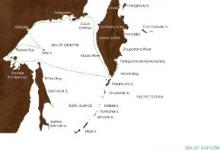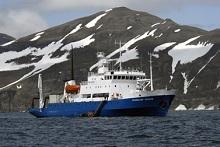Recently Viewed Cruises
- Enderby, Sea of Okhotsk ex Petropavlovsk ReturnAdd to favourites
- Sojourn, St Petersburg and The Baltic ex Copenhagen to StockholmAdd to favourites
- Whisper, ex Stockholm to CopenhagenAdd to favourites
- Pacifica, Scandi Russia Cruise ex Kiel ReturnAdd to favourites
- Braemar, Scandinavia & St Petersburg M1314 ex Dover ReturnAdd to favourites
- Catch up on Cruising: Latest cruise news in bite size
- Royal Caribbean International raises the bar
- Classy Astor fills gap in market
- Oceanic Discoverer
- Ab Fab Oosterdam
- Frequently Asked Questions
-
Enderby, Sea of Okhotsk ex Petropavlovsk Return
Nights 16 Ship Spirit of Enderby Star Rating Specialty Departs Petropavlovsk, Russia Sailing 2013: 5 Jun Ports of Call Petropavlovsk, Utashud Island and Vestnik Bay, Sakhalin, Iony Island, Okhotsk, Magadanskiy Wilderness Preserve, Kamchatka Coast Please enquire about this cruise for pricing.
16 Night Cruise sailing from Petropavlovsk roundtrip aboard Spirit of Enderby.
In the language of its indigenous people, the Sea of Okhotsk translates as something like the 'Sea of Hunters' or 'Hunters Sea'. It's our first indication of the abundance of wildlife in the region. Despite the hunting that has gone on over the years, this sea remains one of the richest in the world - but there is so little known about it. The freshwaters of the Amur River flow into this vast, naturally-sheltered sea and it freeze's into ice-floes that make it impassable for much of the year.
Dominating the Northwest Pacific, the sea is bounded to the north and west by the Russian continent and the Kamchatka Peninsula to the east, while the Kuril Islands and Sakhalin Island guard the southern border. Its coasts were home to a number of indigenous peoples: the Nivikh, Oroki, Even and Itelmen - mostly now displaced by the advance of the modern world, though descendants can still be found practising a way of life handed down by their ancestors.
Our expedition will unlock many secrets of this virtually unexplored region. On Talan Island we visit a huge colony of Tufted Puffins and on the cliffs tumbling round the back of forgotten islands, we'll find thousands of seabirds. Millions more breed on the islands scattered across the sea. Soaring above the archipelagos is the huge and beautiful Steller's Sea Eagle. But birds compose only part of the rich wildlife tapestry of the region: we will see rivers churning with salmon as they roar through taiga forests, wild hills roamed by wolves, Big Horned Sheep, Arctic Fox and, with luck, we'll catch sight of the mighty Kamchatka Brown Bear.
Day 1: Petropavlovsk-Kamchatskiy
Arrive into Petropavlovsk-Kamchatskiy the capital and administrative centre of the Kamchatka Region and board the Spirit of Enderby.
After an opportunity to settle into your cabin we will set sail through Avacha Bay, one of the greatest natural harbours in the world and head south towards Utashud Island.
Day 2: Utashud Island
The Utashud are a small group of islands off the eastern coastline of the Kamchatka Peninsula. They are far enough offshore and small enough as to avoid disturbance from animals and activities on the mainland consequently they have an abundance of birds and marine life. This morning if conditions are suitable, we will take a Zodiac excursion around the islands; this will be your first close encounter and chance to view some of the regions seabirds including Tufted and Horned Puffins and provides us with photographic opportunities. There is also a good population of Sea Otters and harbour seals. This afternoon we sail around Cape Lopatka - the southern tip of the Kamchatka Peninsula and into the Sea of Okhotsk.
Day 3: At Sea
We have a day at sea as we cruise north-west across the Sea of Okhotsk towards the northern tip of Sakhalin Island. The upwelling around the edge of the Deryugin Basin should be an ideal location to see cetaceans. The Sea of Okhotsk is renowned for cetaceans; from the mid 19th century whaling ships worked these waters but since the cessation of whaling, numbers are increasing.
Day 4: Northern Sakhalin Island
The north-east part of Sakhalin Island especially is a regular feeding ground for Western Grey Whales. Critically endangered, with only about 120 animals left in the wild and many questions still unanswered about their ecology, they were believed to be extinct after heavy exploitation during the 19th and 20th centuries, but miraculously survived. The water around northern Sakhalin Island consistently holds the biggest congregation of whales during summer months; they come every year to forage in the productive waters off the shelf. This area has also become a place of collision between oil-drilling companies and conservation organisations because a lot of seismic work is taking place in this region.
Days 5 to 6: Shantar Archipelago
This massive archipelago consists of 15 islands, of which there are four big ones, surrounded by numerous smaller rocks. It covers a vast area in the west of the Sea of Okhotsk and the climate is somewhat harsh. Sea ice gets stuck in the strait for a long time before it melts, so there are only a few months of ice-free sea and ice floes can be seen as late in the season as July.
Further inland, Brown Bears are the biggest terrestrial animals, but many other creatures can also be found. There are rivers, lakes and spectacular waterfalls to explore, and it's all uninhabited apart from the staff at weather stations.
Day 7: Mal'minskie Islands and Fedora Bay
This is an incredible and wild area on the west coast of the Sea of Okhotsk. These small islands form part of the Dzhugdzhursky Nature Reserve, which is one of the wildest and least-studied reserves in Russia. It covers a huge territory of eight thousand hectares and consists of three parts, with a big marine area attached. The reserve epitomises the harsh Siberian climate and breathtaking landscapes of the region.
Day 8: Iony Island
A small island in the vastness of the Sea of Okhotsk, it is over 200 kilometres away from the mainland. Completely uninhabited with only an automatic weather station and a small hut of unknown origin, it is a crucial location for the endangered Steller Sea Lion population.
We will cruise around the island and surrounding rocks, enjoying magnificent birding and watching numerous sea lions all around.
Day 9: Okhotsk Town
The first settlement was established on this site by Russian Cossacks in 1647, making it one of the earliest towns of the Russian Far East. After the famous explorer Commander Vitus Bering visited here on the way to Kamchatka on his first expedition, he proposed founding a navigation school for young sailors. Since then, and for almost a century, Okhotsk was an important port on the Far East coast, from which many expeditions departed.
Day 10: Talan Island
A tiny island in the northern Sea of Okhotsk, it supports an unbelievable diversity of wildlife. Despite its size this island has one of the largest seabird colonies in the north of the Sea of Okhotsk. Over 140 species of birds can be observed on the island, most of them migratory. Over 1.8 million birds bring the cliffs alive and obscure the sky as they fly out to sea. Gulls, kittiwakes, Thick-billed Murres, Horned and Tufted Puffins, Crested, Whiskered and Parakeet Auklets, Ancient Murrelets and many other species form a birdwatcher's paradise.
Day 11: Zavyalov Island and Magadan
Thirty miles off the entrance to Magadan Harbour is Zavyalov Island - we hope to make an expedition landing in search of wildlife encounters, wild flowers and scenery.
Magadan is the true cultural capital of the region.
Day 12: Koni Peninsula (Magadanskaya Reserve)
This peninsula south of Magadan is part of the Magadanskaya Reserve and we will likely be accompanied by a Ranger for our landings. It is a genuine expedition day as there are numerous sheltered bays and harbours with rivers flowing in to explore the largest of which is the Zabiyaka Bay. All the landings offer opportunities for hikes, photography, natural history observations including mammals, birds and plants.
Day 13: Yamskiye Islands
The huge bay in the northern part of the Sea of Okhotsk (Penzhinskiy) is covered with ice for half of the year and is famous for its irregular and very high tides. It is home to four seal species, Bearded, Ringed, Ribbon and Largha, along with the Steller Sea Lion. There are also many whale species that can be seen in the area - Bowhead, Northern Right, Grey, Humpback and Fin.
Days 14 to 15: Kamchatka Peninsula (West Coast)
During the night we will have crossed to Cape Yuzhnyy on the wild west coast of the Kamchatka Peninsula and will make our way south. Many species of salmon swim upriver throughout the summer to spawn, which in turn attracts many predators like Steller's Sea Eagles and, of course, the King of Kamchatka - the Brown Bear.
Day 16: Bukhta Russkaya
This afternoon will be our last landing as we make our way north back along the Kamchatka coast to Petropavlovsk-Kamchatskiy where our journey began. If the weather is fine, there should be fantastic views of the many snow-covered volcanoes that dominate the southern part of the peninsula.
Day 17: Petropavlovsk-Kamchatskiy
During the night the Spirit of Enderby will enter Avacha Bay, after a final breakfast it will be time to disembark.







